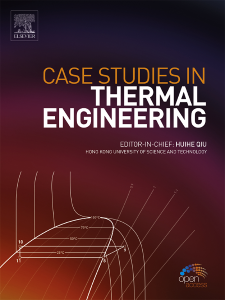A two-dimensional thin film structure with spectral selective emission capability suitable for high-temperature environments
IF 6.4
2区 工程技术
Q1 THERMODYNAMICS
引用次数: 0
Abstract
Spectral selective emission materials, characterized by their high emission efficiency within specific wavelength ranges, play a crucial role in various fields such as infrared stealth and radiative cooling. In this study, leveraging the tunneling effect of ultrathin metal layers and the impedance matching principle, we designed a one-dimensional multilayer thin film structure composed of Mo/Ge/Al. This design successfully achieved spectral selective emission within the 3–14 μm infrared spectrum range, showcasing superior high-temperature infrared stealth capabilities. Research findings indicate that the infrared atmospheric window (ε3–5 μm = 0.40, ε8–14 μm = 0.30) maintains a low emissivity within the temperature range from room temperature to 400 °C, while high emissivity in non-infrared atmospheric windows (ε5–8 μm = 0.81) enables radiative cooling. The use of high emissivity in the non-infrared atmospheric window reduced the surface temperature of this structure by 15.3 °C compared to untreated Si substrate under similar heating conditions. The temperature reduction was 34.1 °C when compared to a Si substrate coated with a 200 nm Al film. This straightforward and easily scalable structure not only presents novel solutions for applications in infrared stealth and radiative cooling but also holds vast potential for diverse fields including military, aerospace, and industrial manufacturing, injecting fresh impetus and possibilities into technological advancement.
适用于高温环境、具有光谱选择性发射能力的二维薄膜结构
光谱选择性发射材料具有在特定波长范围内发射效率高的特点,在红外隐身和辐射冷却等多个领域发挥着重要作用。在这项研究中,我们利用超薄金属层的隧道效应和阻抗匹配原理,设计了一种由 Mo/Ge/Al 组成的一维多层薄膜结构。这一设计成功实现了 3-14 μm 红外光谱范围内的光谱选择性发射,展示了卓越的高温红外隐身能力。研究结果表明,红外大气窗(ε3-5 μm = 0.40,ε8-14 μm = 0.30)在室温到 400 ℃ 的温度范围内保持了低发射率,而非红外大气窗的高发射率(ε5-8 μm = 0.81)则实现了辐射冷却。在类似的加热条件下,与未经处理的硅基底相比,在非红外大气窗口中使用高发射率可使该结构的表面温度降低 15.3 °C。与涂有 200 纳米铝膜的硅基板相比,温度降低了 34.1 °C。这种简单易行、易于扩展的结构不仅为红外隐身和辐射冷却应用提供了新的解决方案,而且在军事、航空航天和工业制造等不同领域也蕴藏着巨大的潜力,为技术进步注入了新的动力和可能性。
本文章由计算机程序翻译,如有差异,请以英文原文为准。
求助全文
约1分钟内获得全文
求助全文
来源期刊

Case Studies in Thermal Engineering
Chemical Engineering-Fluid Flow and Transfer Processes
CiteScore
8.60
自引率
11.80%
发文量
812
审稿时长
76 days
期刊介绍:
Case Studies in Thermal Engineering provides a forum for the rapid publication of short, structured Case Studies in Thermal Engineering and related Short Communications. It provides an essential compendium of case studies for researchers and practitioners in the field of thermal engineering and others who are interested in aspects of thermal engineering cases that could affect other engineering processes. The journal not only publishes new and novel case studies, but also provides a forum for the publication of high quality descriptions of classic thermal engineering problems. The scope of the journal includes case studies of thermal engineering problems in components, devices and systems using existing experimental and numerical techniques in the areas of mechanical, aerospace, chemical, medical, thermal management for electronics, heat exchangers, regeneration, solar thermal energy, thermal storage, building energy conservation, and power generation. Case studies of thermal problems in other areas will also be considered.
 求助内容:
求助内容: 应助结果提醒方式:
应助结果提醒方式:


